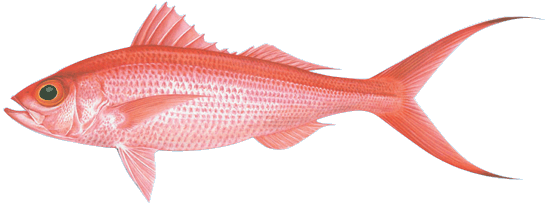
LONG-TAIL RED SNAPPER (ONAGA)
Scientific Name: Etelis coruscans
Hawaiian Name: `Ula`ula koa`e
Japanese Name: Onaga; Hamadai
Onaga is one of Hawaii’s fish better known by its Japanese name than by its Hawaiian name, ula`ula koae. It is also called ruby snapper or scarlet snapper, due to it’s brilliant red color. Onaga have a unique profile with distinctive caudal fins that end in long, slender points.
Onaga has clear, light pink flesh similar to that of the opakapaka but somewhat softer and moister. Fish caught during the winter months seem to have a higher fat content than those caught in the summer; hence onaga yield the best sashimi during the winter season.
Most of the onaga caught off the Hawaiian Islands range in size from 1 to 18 pounds. Harvested exclusively with vertical hook-and-line gear, this bottomfish is caught in deep waters at 600-1000 feet.
FISHING METHOD
All Hawaii onaga are line-caught. All onaga are caught by deepwater handline gear with power reels.
SEASONALITY
Onaga is harvested mainly during the fall and winter months (October to March). Its availability peaks during the month of December when demand (and prices) for red-colored snappers among Hawaii’s Japanese population is at its peak.
PREPARATION NOTES
Texture: Soft & Moist
Flavor: Delicate
Suggested Preparations: Raw (sashimi), Baked, Steamed, Sautéed, Soup
Hawaii’s residents have a strong culturally-oriented demand for long tail red snappers for ceremonial occasions such as the New Year’s season and weddings, when onaga sashimi is traditionally served.
HEALTH & NUTRITION
Hawaii Long-tail Red Snapper is an excellent source of healthy, extra lean protein. It is also low in saturated fat and low in sodium. It is rich in niacin, vitamin B6, vitamin B12, phosphorus and selenium. Hawaii Long-tail Red Snapper also provides about 875 mg of omega-3’s (DHA and EPA) per 4 ounce serving of fresh fish. Click here for nutritional labels and claims.
Click here to download a two-page description of this species.

